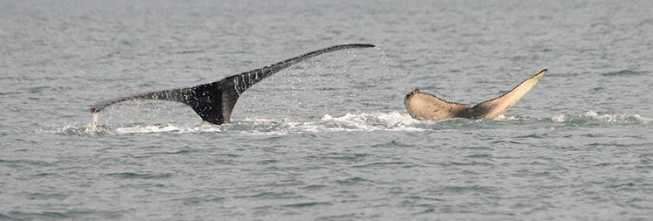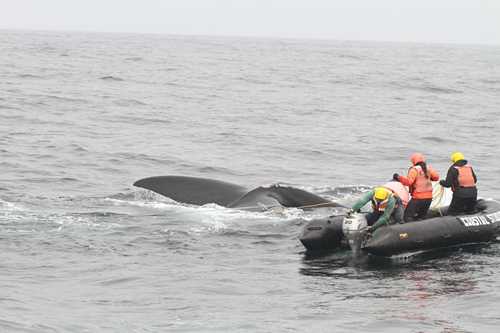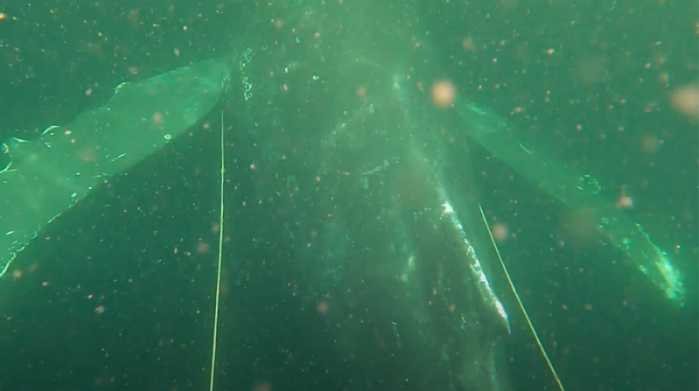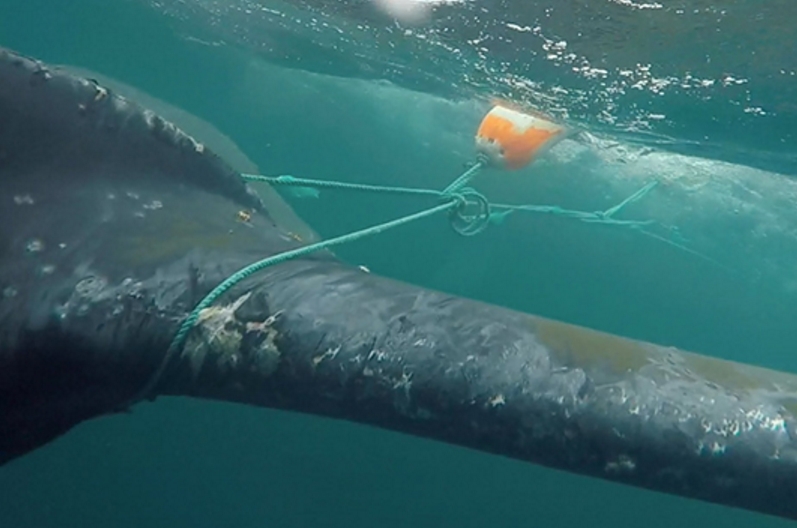New technical memorandum provides 31 years of killer whale entanglement history in Alaska.

NOAA Fisheries has released a new technical memo, Killer Whale Entanglements in Alaska: Summary Report 1991–2022. It provides comprehensive detail of 37 reported killer whale entanglement cases in Alaska over the past three decades.
This technical memo has been in development since spring of 2023, prior to reports of summer 2023 killer whale takes.
The entanglement of killer whales in fishing gear or marine debris is a serious animal welfare issue and conservation concern. It affects both the marine mammals and the Alaska fishing industry. Killer whales feed on the bait or the catch of fishers, which makes them more susceptible to entanglements. They can become entangled in fishing gear, marine debris, or other materials, which can lead to injury or death. Marine mammal entanglements are also detrimental to the fishers who incur financial and material loss when their gear becomes lost or damaged by the interaction.
Entanglement Details
Thirty of the entanglements occurred in the Bering Sea, one in the Arctic, one in the Gulf of Alaska, and five in Southeast Alaska.
Reported cases are categorized by entangling material:
- Trawl gear: 20
- Longline: 10
- Pot gear: 2
- Kelp: 2
- Mix of gear: 1
- Anchor line: 1
- Unknown line: 1
Trawl Net Entanglements
Trawl net entanglements comprised the majority of reported killer whale entanglements in Alaska:
- Commercial flatfish trawls (Bering Sea, Aleutian Islands): 13
- Commercial Pollock trawls (Bering Sea, Aleutian Islands): 7
Five of the 20 trawl net entanglement cases were categorized as alive, disentangled or partially disentangled, and released with serious injuries. Fifteen were mortalities.
Longline Entanglements
Longline entanglements were the second most frequent type of killer whale entanglements in Alaska:
- Commercial Pacific cod longline (Bering Sea, Aleutian Islands): 6
- Greenland turbot longline (Bering Sea, Aleutian Islands): 3
- Commercial halibut and sablefish longline (Southeast Alaska): 1
While some longline fisheries use pots or traps, all longlines reported in this technical memorandum were using hooks on their gear at the time of the entanglement. Two of the 10 longline entanglements involved killer whales that were released alive. One of these was considered seriously injured and one considered non-seriously injured. Eight were mortalities.
Pot Gear Entanglements
In the two cases of pot gear entanglements, one entanglement was never resolved and classified as a serious injury. In the other case, involving recreational shrimp pot gear, the whale was able to self-release.
Human-caused mortalities and serious injuries are considered removals from the population. They are compared against the stock’s potential biological removal level in the Stock Assessment Reports as part of the evaluation of the stock’s status.
This report includes only data from entanglements that occurred in Alaska waters. There have been cases of Alaska killer whale stocks becoming entangled in other regions, such as along the West Coast.
Alaska Killer Whale Stocks
NOAA Fisheries has conducted genetic testing to identify which stocks the entangled killer whales were from. Twelve of the 37 entanglements were identified to stock:
- Nine were from the Eastern North Pacific Alaska Resident stock
- Three were from the Eastern North Pacific, Gulf of Alaska, Aleutian Islands, and Bering Sea Transient stock
The transient whales were all entangled by trawl fisheries, while the nine resident whales were entangled by trawls, longline, and mixed gear.
These entanglements demonstrate the need for more research and development of killer whale depredation deterrents or other mitigation measures for commercial fisheries.
Entanglement Reports and Response
NOAA Fisheries conducts, authorizes, and oversees entanglement responses for all cetaceans in U.S. waters, including killer whales. Responding to entanglements properly is crucial for both the welfare of the whales and the safety of responders. We document as many entanglement incidents as possible to gain information that might mitigate the threats related to entanglement in the future.
In cases where entanglements cannot be prevented, we collect data to help with stock management, including:
- Skin samples
- Photographs of the whale and of the entanglement
- Detailed descriptions regarding the entanglement
NOAA Fisheries provides annual reports on entangled marine mammals to support the development of marine mammal stock assessment reports.
We have collected data on killer whale entanglements for several decades under three primary programs. Different reporting requirements have been instituted over time, resulting in a shift in the predominant reporting sources as well as a general increase in case reporting in more recent years.
Alaska Marine Mammal Stranding Network
The Network collects data on cetacean entanglement reports in Alaska, including reported killer whale entanglements. Seven of the 37 reports were submitted by the public solely to the stranding network.
Marine Mammal Authorization Program
The program was created in 1994. It allows exceptions to the take moratorium for incidental take in commercial fisheries provided certain requirements, including reporting, are met. Thirteen incidents were self-reported by fishers through the program. Eleven of these 13 were also observed, but the MMAP source is preserved in the Tech Memo to capture the fishermen’s efforts to self-report.
North Pacific Observer Program
The program provides the regulatory framework for agency-certified observers to collect data on groundfish and halibut fisheries. Federal commercial fisheries observers reported 28 entanglements in this report.
Commercial fishers who inadvertently entangle a killer whale are authorized to conduct a response under the Good Samaritan exemption of the Marine Mammal Protection Act. Only NOAA can authorize a disentanglement attempt. Entanglements should also be reported to the stranding hotline at (888) 774-7325.
Members of the public are not authorized to attempt disentanglement. Instead, they should report the entanglement immediately to the Alaska Marine Mammal Stranding Network at (877) 925-7773.
The entanglement response network is composed of highly trained individuals who are familiar with whale biology and behavior, have the proper tools and equipment, and know how to maximize human and animal safety in proximity to whales.
More Research Needed to Develop Deterrents and Bycatch Mitigation
Additional research could expand our understanding of killer whale behaviors and interactions with anthropogenic material. Suggestions and innovations by fishers to reduce killer whale gear interactions could be applied statewide.
Our report reviews several mitigation strategies that may prevent or reduce killer whale interactions with fisheries.
- Fishing in areas that offer more room for both human fishers and killer whales can reduce negative interactions. In Norway, fishery interactions with killer whales increase when fishing in narrow fjords, and decrease when fishing occurs in wider fjords.
- Checking gear regularly, minimizing soaking times, or ceasing fishing when killer whales are present may reduce the risk of entanglement. This is especially important for trawl nets, longlines, gillnets, or other fishing operations that soak longer than killer whales can survive without air, as they present a higher risk to entangled animals.
- Proper gear retrieval can prevent the ingestion of marine debris or fishing gear. Ingesting marine debris or fishing gear may not represent an immediate threat to the animal’s life, but can result in a slow, agonizing death.
- When whales cannot be avoided, other techniques to minimize depredation include using decoy sets or working in coordination with other boats to fish one set more quickly.
- The use of pingers, exclusion devices, escape hatches, net sleeves, and other methods to reduce killer whale depredation and bycatch requires more research and development.
New sources of data will increase our understanding of the extent of killer whale entanglements as fisheries evolve, mariculture becomes more prevalent, and killer whale populations change over time.
We intend this technical memorandum to be used as a resource for researchers, policy makers, and stakeholders working to better understand and lessen the impacts of entangling materials, including fishing gear, on killer whales in Alaska.
[content id=”79272″]








